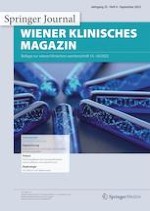Anzeige
24.08.2022 | Nephrologie
Hochdruck und Nebenniere
Erschienen in: Wiener klinisches Magazin | Ausgabe 4/2022
Einloggen, um Zugang zu erhaltenZusammenfassung
Der primäre Hyperaldosteronismus (PHA) gilt als häufigste Form der sekundären Hypertonie und ist durch eine vermehrte, autonome Aldosteronproduktion der Nebennierenrinde gekennzeichnet. Der PHA ist mit einer deutlich erhöhten kardiovaskulären Morbidität und Mortalität assoziiert. Eine frühe Diagnose und eine spezifische Therapie sind daher von entscheidender Bedeutung. Der Diagnosealgorithmus gliedert sich in das Screening, einen Bestätigungstest sowie die Subtypdiagnostik. Ein niedriges Renin ist ein wichtiger Hinweis für einen PHA, das Aldosteron kann hingegen normal oder erhöht sein. Leitlinien empfehlen eine Adrenalektomie für geeignete Patienten mit gesichertem unilateralen PHA. Bei etwa 37 % der Patienten kommt es postoperativ zu einer kompletten klinischen Heilung. Für die medikamentöse Therapie sind Mineralokortikoidrezeptorantagonisten Mittel der Wahl.
